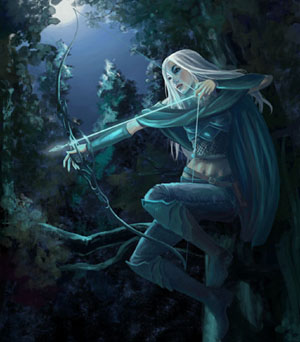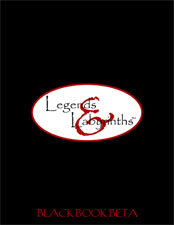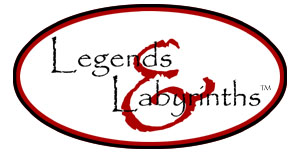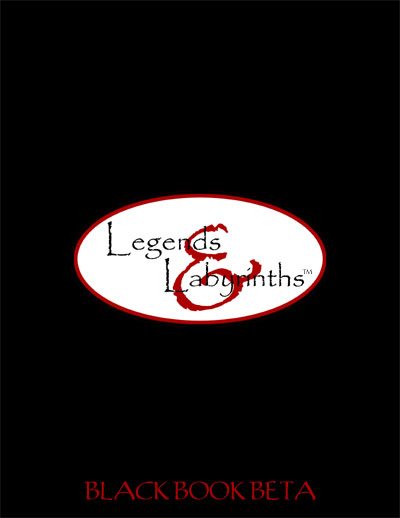 I’ve been playing and running roleplaying games for about 22 years now. In that time, I’ve seen a lot of new players come to the table for the first time. This has been particularly true in the last couple of years as I’ve been running an open table. And if there’s one thing I’ve learned in watching all these new players, it’s this:
I’ve been playing and running roleplaying games for about 22 years now. In that time, I’ve seen a lot of new players come to the table for the first time. This has been particularly true in the last couple of years as I’ve been running an open table. And if there’s one thing I’ve learned in watching all these new players, it’s this:
Nothing hooks them like character creation.
Some people swear by pregens, but I’m here to say that it really isn’t the same thing: Creating a character fires up the imagination. It gives them a sense of ownership in the game. It gets them thinking about all the cool things that they’re going to do with that character. If they’re the type of people who are going to get excited about playing an RPG, then character creation is going to hook them.
This is only true, however, if character creation is accessible to them. This requires three things to be true:
- Character creation must be quick.
- Character creation must be fun.
- Character creation must be comprehensible.
If you’ve got a character creation system that takes 60 minutes? That’s not newbie friendly.
If the bulk of character creation is balancing equations or juggling spreadsheets? That’s not fun.
If your character creation system requires decisions which are only meaningful if you’ve already read and understand large chunks of the 200 page rulebook? Those decisions are confusing, meaningless noise to the new player.
ABILITY SCORES – A BASIC CASE STUDY
 This last factor — the ability for new players to comprehend the decisions they’re making during character creation — is why Legends & Labyrinths came really, really close to having a character creation system in which ability scores are generated in order.
This last factor — the ability for new players to comprehend the decisions they’re making during character creation — is why Legends & Labyrinths came really, really close to having a character creation system in which ability scores are generated in order.
Ultimately I decided that the nature of the six ability scores are clear enough that new players can make meaningful decisions — Do I want my character to be stronger or smarter? Faster or wiser? — even if they don’t necessarily understand all of the finer mechanical implications of those choices.
But this, in my opinion, is near the limit in terms of the types of decisions you want new players making. Anything more than that and they begin to bog down. Why? Because people want to understand the decisions they’re making. And in seeking to understand those decisions, more and more of the game mechanics need to be explained to them. At a certain point, this transitions from “acceptable prelude to playing the game” and becomes “why are we still performing this boring chore?”. The creative impulse is lost.
(Besides, if they don’t understand it, then the decision is meaningless anyway and you should be automating it anyway.)
Which is why Legends & Labyrinths doesn’t feature a point-buy method. I’ve seen new players tackle those systems, and it always bogs them down. Arranging six stats according to which ability score you want to have the best score? Acceptable choice. Deciding whether you want a 15 Str or 16 Str, and how does that comparative benefit of that choice affect the Dex and Int scores you can afford to purchase? It’s meaningless noise without a deeper understanding of the system.
Okay. So why not give a standard array and have them assign it? That’s a more balanced approach, right?
Well, to boil it down: It’s less fun.
I understand (and perhaps even prefer) the experience of crafting your character. But new players tend to interpret “rolling the dice” as “playing the game” — so when the first thing you do during character creation is to roll some dice, it gives them the sense that they are immediately playing the game. (Keep character creation short and you can sustain that feeling.) There’s also a reason why we enjoy gambling: The observation of an uncertain outcome is exciting.
This aspect of turning character creation into a unique mini-game is something the Arneson and Gygax did well, and which I feel more games would benefit from. (This is particularly true because, if properly developed, I think this could give many RPGs a form of enjoyable solo play.)
On top of that, rolling for ability scores is a rote activity. It gives a concrete task that requires no decision-making (just pick up the dice and start rolling them). It gets the ball rolling on character creation and cuts right through any dithering. You wanna play? Great. Here’s 4d6. Roll ’em.
As a final tangent, there was another reason I considered “roll ’em in order” for Legends & Labyrinths: It adds a distinct aspect of “discovery” to the character creation process.
In improv theater terms, the system is mechanically making an offer. It’s providing a creative seed that gets your creative juices flowing by demanding extrapolation and explanation: Why is this guy strong? What forced him to become quick-witted? What sort of person do these stats belong to? Effectively, an offer like this jump-starts the creative process.
(It can also make the next decision — what class do you want to be? — into a fait accompli, which may be undesirable for experienced players, but can be great for the new player.)
THE “RULE” OF 7
Okay. Now take that level of thought and apply it to every aspect of character creation.
In this I was heavily influenced by Delta’s “Magic Number Seven”. To sum up a really great post:
- Working memory capacity for most adults is in the range of 7 +/-2 objects. Short-term memory capacity is also 7 +/-2 when memorizing strings of random digits.
- Beyond these limits, mental functioning rapidly drops off.
In other words, we are generally pretty good at holding somewhere between 5 and 9 objects in our mind at a given time. Any more than that and it becomes increasingly difficult (or impossible).
In terms of character creation, this is significant because it places an upper limit on the number of options that we can simultaneously consider. Basically, for any decision point you have during character creation, new players shouldn’t need to decide between more than, say, 9 objects.
(Experienced players can deal with more options for a couple of a reasons. First, long-term memory is more flexible. Second, our experience with the system allows us to “chunk” it out: If you can take 30 options and break them into 5 usable groups, then you can choose between the five groups (easy) and then choose between the six options in the group you’ve chosen (also easy).
For example, the experienced player can say: “I want to play a martial character.” By applying this filter he limits his decision to 5 classes: Barbarian, fighter, monk, paladin, or ranger. New players, on the other hand, don’t have the deep understanding of the system necessary to apply that filter. So you either need to find some way to apply it for them or reduce the number of options.)
APPLYING THE RULE
It starts from the very top: Legends & Labyrinths breaks character creation down into eight steps:
- Roll Ability Scores
- Pick a Race
- Pick a Class
- Select Starting Equipment
- Calculate Saving Throws
- Calculate Combat Scores
- Calculate Skill Modifiers
- Character Description
This breaks the process down into a manageable number of “chunks”. (Depending on how you count, the total process of character creation actually takes something like 25-40 discrete steps. If you simply presented that as a list, it would be impossible to get any sense of “how character creation works”.)
Now, let’s take a look at how many options each major decision point has in Legends & Labyrinths:
- Ability Scores: 6 (Str, Int, Wis, Dex, Con, Cha). Perfect.
- Races: 6 (Dwarf, Elf, Half-Elf, Halfling, Half-Orc, Human). Perfect.
- Classes: 6 (Barbarian, Cleric, Fighter, Rogue, Sorcerer, Wizard). Perfect.
- Alignment: 9. Manageable, and we also attempt to “chunk it” by deciding each axis (for two choices of 3 options each).
- Armor: 9. (7 armors + 2 shields.) This is also chunked into light (3 options), medium (2 options), and heavy (2 options).
- Weapons (Melee): 10. A little high. In practice, however, I think players will generally focus on their best proficiency which breaks the list into two manageable chunks — simple (4 options) and martial (6 options). There’s also natural chunking between one-handed (5 options), two-handed (3 options), and double weapons (2 options).
- Weapons (Ranged): 10. Same principle as the melee weapons — a little high, but with natural chunking to give a manageable decision tree.
Of course, the “Rule” of 7 is not the only consideration in designing the game. That’s why there are 10 melee weapons and 10 ranged weapons: It’s a little high according to the “Rule” of 7, but it’s also important to give a range of options within each proficiency group.
Similarly, I obviously made no effort to limit the range of adventuring gear available to 7 items. Limiting some options only serves to eliminate essential utility. On the other hand, understanding this led me to emphasize the “shopping trip” nature of adventuring gear on page 108 of the rulebook:
For the wandering adventurer, having the right tool for the job is often the difference between life and death. Take the time to peruse the equipment list for anything that might prove useful on your current venture. And don’t be afraid to think outside the box: Look for ways to use equipment in unusual and clever ways.
On that page you’ll also note that I “chunk out” a couple of short checklists of “essential equipment” — one for individuals (6 options) and another for the party as a whole (6 options). Coincidence? Not really.
(I put together the full list of “necessary supplies” and found that it “felt too long”. After a bit, I realized that the “Rule” of 7 applied and found a way of chunking it out into two smaller and more manageable lists.)
It should also be noted that the “Rule” of 7 can also apply in other areas of a game system: For example, 3E features only three types of saving throws. In addition to providing a universal coverage that was lacking in previous editions, this is also a more manageable number than the 10 categories of saving throw presented in 1st Edition. So, particularly for a neophyte DM, it’s much easier in 3E to figure out what type of save should apply in an unusual situation.

CLIMB INTO YOUR LABYRINTH AND FORGE YOUR LEGEND TODAY!
















